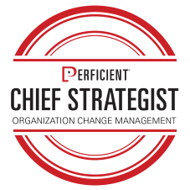In my preceding blog post, we discussed some examples of increasing success and managing disruption with change management. Today, we’ll discuss the significance of organizational change management (OCM) to an effective Microsoft Office 365 (O365) implementation.
Consider the implications that change management can have on implementing a solution like O365. O365 is a cloud-based subscription service of productivity tools and applications that are designed to enable collaboration among employees in today’s modern, digital workplace. The O365 suite includes tools such as Word, Excel, and PowerPoint, along with collaboration tools like Exchange, Skype for Business, and OneDrive for Business.
Office 365 continues to be Microsoft’s fastest-growing product, In its 2018 Annual Report, the company said that more than 135 million people use Office 365 commercial every month.4
Considering the breadth of tools and apps available across the O365 suite it’s clear that effective OCM can play an important role in an O365 implementation. It’s important that your end users are not only trained on the entire suite but also informed as the migration process takes place.
For some applications, it is imperative to keep users updated on what is happening, when it will happen, and how it will impact them. Consider an Exchange Online migration. Most people use email on a regular basis and rely heavily on information contained in their email accounts. Even if a user leverages another platform (e.g., Lotus Notes or Gmail), they are frequently concerned about what will happen to their “old” emails and how they will manage through the periods of coexistence. This can cause anxiety and make for a rocky transition.
Other workloads, such as SharePoint Online, OneDrive, and Teams will offer end users new ways of working. But the unknown can be frightening. While the benefits of being able to collaborate in new ways – such as sharing files or working on documents at the same time – are plentiful and can have many positive advantages, the applications and intricacies of using the apps to their full potential may be foreign to users.
In fact, it is estimated that the common end user only leverages about 15% of the functionality that exists within the O365 suite. That means that deploying key pillars of change management will be imperative in enabling end users to leverage all of the O365 features to maximize your investment.
Below are some examples of the importance of OCM in an Office 365 implementation:
Working in the cloud has a new meaning (and opportunities) for users.
For many, the “cloud” is still an ambiguous term that is loosely thrown around. You have to make it real and tangible for employees. What does it mean to them? How can it benefit them?
O365 initiatives reach a large portion – sometimes all – of the workforce.
When you’re impacting the entire company, can you afford to mess it up? For many companies, people are their biggest asset and investment. How you take care of people during a major implementation says a lot about the company, and will lead to happier, motivated, and more-productive employees.
People are expected to change behaviors (e.g., work in new collaborative ways), not just use a new tool.
Changing behaviors is hard! People are naturally resistant to change, and when it comes to behaviors, they resist even more. A concerted effort is required to ensure that the right behaviors change and can be sustained over time.
If not managed properly, the period of co-existence, where some users have migrated to O365 while others remain on the legacy systems, can cause high levels of confusion and frustration.
Users will ask questions like: What happens if I’ve been migrated, but my colleague hasn’t? Do I have to reschedule all of my calendar meetings and resend invites? What about the conference rooms I’ve reserved? These questions and more are common and need to be addressed when dealing with users who will live in a period of coexistence during a migration.
Access anywhere at any time via a mobile device creates new impacts (set-up, access, etc.).
It’s one thing to work in the cloud. It’s another thing to get there! While it may be easy for techies, configuring devices to provide the desired access isn’t always as easy for the everyday user. Ensuring people have what they need, or know where to get help, is key to overcoming the anxiety that is often associated with mobile usage.
For more insight on how organizational change management boosts adoption of Office 365, download our guide here or below.
About the Author 
David Chapman serves as General Manager and Chief Strategist for Perficient’s Organizational Change Management practice. He has more than 20 years of management consulting experience, specializing in the change management discipline. David brings his unique insight to the people aspects of any change from technology implementations to broader strategic organizational imperatives.

